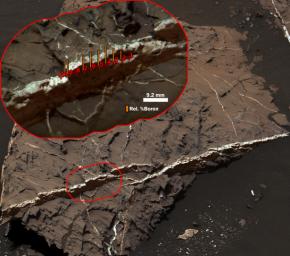
|
Boron in Calcium Sulfate Vein at ‘Catabola,’ Mars
- Click the image above for a larger view
- Full-Res JPEG (1996 x 1758) (465.6 kB)
- Full-Res TIFF (1996 x 1758) (9.6 MB)
Caption:
The highest concentration of boron measured on Mars, as of late 2016, is in this mineral vein, called "Catabola," examined with the Chemistry and Camera (ChemCam) instrument on NASA's Curiosity rover on Aug, 25, 2016, during Sol 1441 of the mission.
This two-part illustration shows the context of the erosion-resistant, raised vein, in an image from Curiosity's Mast Camera (Mastcam), and a detailed inset image from ChemCam's remote micro-imager. The inset includes indicators of the boron content measured at 10 points along the vein that were analyzed with ChemCam's laser-firing spectrometer. The vein's main component is calcium sulfate. The highest boron content identified is less than one-tenth of one percent. The heights of the orange bars at each point indicate relative abundance of boron, compared with boron content at other points.
The scale bar for the inset is 9.2 millimeters, or about 0.36 inch. The ChemCam image is enhanced with color information from Mastcam.
Presented at the 2016 AGU Fall Meeting on Dec. 13. in San Francisco, CA.
Background Info:
Mastcam and ChemCam are two of 10 instruments in Curiosity's science payload. Malin Space Science Systems, San Diego, developed and operates Mastcam. The U.S. Department of Energy's Los Alamos National Laboratory, in Los Alamos, New Mexico, developed ChemCam in partnership with scientists and engineers funded by the French national space agency (CNES), the University of Toulouse and the French national research agency (CNRS).
ChemCam is one of 10 instruments in Curiosity's science payload. The U.S. Department of Energy's Los Alamos National Laboratory, in Los Alamos, New Mexico, developed ChemCam in partnership with scientists and engineers funded by the French national space agency (CNES), the University of Toulouse and the French national research agency (CNRS). More information about ChemCam is available at http://www.msl-chemcam.com/ .
NASA's Jet Propulsion Laboratory, a division of Caltech in Pasadena, California, manages the Mars Science Laboratory Project and Mars Reconnaissance Orbiter Project for NASA's Science Mission Directorate, Washington.
For more information about Curiosity, visit http://www.nasa.gov/msl and http://mars.jpl.nasa.gov/msl .
Cataloging Keywords:
| Name | Value | Additional Values |
|---|---|---|
| Target | Mars | |
| System | ||
| Target Type | Planet | |
| Mission | Mars Science Laboratory (MSL) | Mars Reconnaissance Orbiter (MRO) |
| Instrument Host | Curiosity Rover | Mars Reconnaissance Orbiter |
| Host Type | Rover | Orbiter |
| Instrument | Chemistry & Camera (ChemCam) | Mast Camera (MastCam) |
| Detector | ||
| Extra Keywords | Color | |
| Acquisition Date | ||
| Release Date | 2016-12-13 | |
| Date in Caption | ||
| Image Credit | NASA/JPL-Caltech/MSSS/LANL/CNES/IRAP/LPGNantes/CNRS/IAS | |
| Source | photojournal.jpl.nasa.gov/catalog/PIA21251 | |
| Identifier | PIA21251 | |
